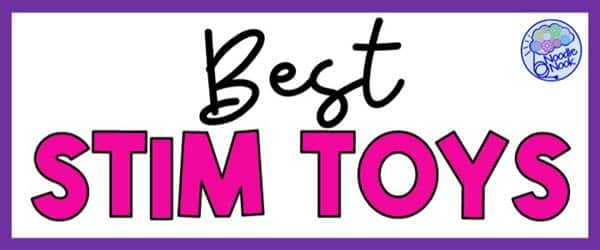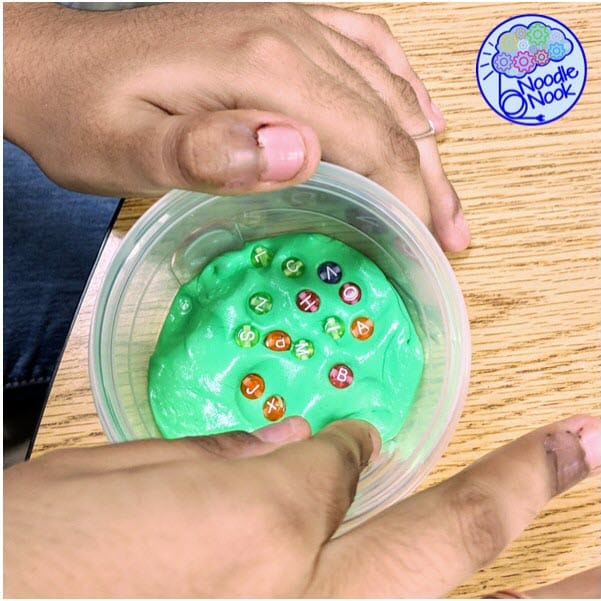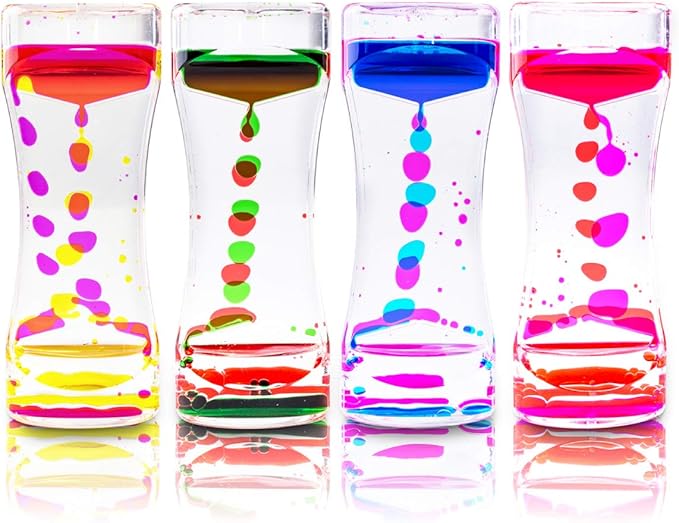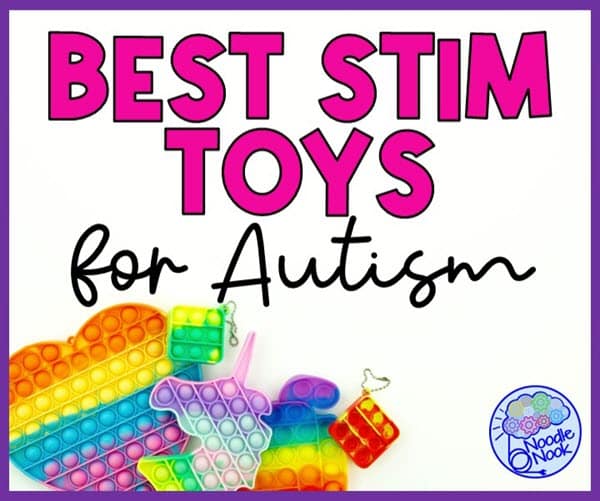If you work with children with sensory issues or a sensory processing disorder, you may be looking for the best way to meet their stim needs. We have tons of ideas on how to integrate fun toys into your sensory rooms, classroom, or even at home for those of you living with fidgety children or kids with ASD. Before we dive into the best stim toys autism, let’s get some core information out there first.
Table of Contents
What is Stimming in Autism?
Stimming, short for self-stimulatory behavior, refers to repetitive movements or behaviors that individuals with autism engage in to regulate their sensory input and respond to their environment.
- Stimming behaviors can be classified into three main categories: sensory, motor, and cognitive.
- Sensory stimming involves seeking out sensory input through behaviors such as hand flapping, rocking, and spinning, or visual stimming, such as looking at lights or flicking fingers in front of the eyes.
- Motor stimming involves movements such as finger tapping, handshaking, or body rocking.
- Cognitive stimming, on the other hand, involves repeating words or phrases, scripting lines from movies or TV shows, or reciting trivia facts.
Stimming is a natural and important way for autistic people to regulate their sensory input and can be a comforting and self-soothing behavior. In other words, stim toys autism classrooms and also for kids that are neurotypical, can really support self-regulation.
Why do Kids with Autism Stim?
Kids with autism stim as a way to regulate their sensory input and respond to their environment. Individuals with autism can experience sensory overload, where their autistic brain is unable to filter out irrelevant information and everything feels overwhelming.
That’s where self-stim behaviors come in.
Stimming behaviors provide a way to manage this overload by providing a predictable and controllable sensory experience. Stimming can help neurodivergent people to calm down, reduce anxiety, and feel more in control of their environment. It can also be a way to express joy, excitement, or frustration.
While stimming can look unusual or even concerning to others, it is an important way for individuals with sensory sensitivities or sensory dysfunction to self-regulate and should be respected and accepted as a natural and valid part of their experience.
What Is the Difference Between Hyposensitive and Hypersensitive in Stimming?
The terms hyposensitive and hypersensitive refer to how an individual’s nervous system processes sensory input. Hyposensitivity means that an individual’s nervous system is less responsive to sensory input than average, while hypersensitivity means that an individual’s nervous system is more sensitive to sensory input than average.
In the context of stimming, a hyposensitive individual may engage in stimming behaviors to seek out more sensory input, as their nervous system is not receiving enough stimulation from their environment. These are your sensory seekers. They may enjoy spinning or rocking to feel more grounded and centered.
Alternatively, a hypersensitive individual may engage in stimming behaviors to cope with an overload of sensory input. These are children who are trying to block out extraneous sensory information. They may cover their ears or flap their hands to block out or cope with the overwhelming sensory input they are experiencing.
It’s important to note that individuals with autism can have a mix of hyposensitivity and hypersensitivity across different sensory modalities, and may engage in stimming behaviors for different reasons depending on the situation and their individual sensory profile.
What are the Ways to Meet Sensory Needs in the Classroom?
Meeting a student’s sensory needs in the classroom is important to help them feel comfortable and engaged in the learning process. Here are some ways to build good sensory systems into your classroom so that students can find a different way to meet their sensory needs:
- Provide a quiet space: Some students may need a quiet space to retreat to when they feel overwhelmed or overstimulated. Creating a designated quiet area with soft lighting, comfortable seating, and sensory tools like a weighted blanket or noise-canceling headphones can provide a safe and calming space for students.
- Sensory-friendly seating: Some students may benefit from sensory-friendly seating options like beanbag chairs, balance balls, or wiggle cushions. These seating options can provide movement and tactile input that can help students stay focused and engaged.
- Incorporate movement breaks: Movement breaks can be an effective way to help students regulate their sensory input and improve their focus. Simple movement activities like stretching, jumping jacks, or yoga poses can provide a break from seated work and help students feel more alert and engaged. You may also have a movement space, depending on the needs of your class. This is a place where whole-body movements are okay and invited.
- Use visual aids: Visual aids can help students with autism process information and understand classroom expectations. Using visual schedules, picture cards, or visual timers can provide structure and predictability that can help reduce anxiety and support learning.
- Offer fidget tools: Providing fidget tools like stress balls, fidget spinners, or putty can offer a way for students to regulate their sensory input and improve focus. Fidget tools can also be discreet and non-distracting, making them a useful tool for students who need sensory input to stay focused.
- Adjust lighting and sound: Bright lights or loud noises can be overwhelming for some students with sensory needs. Adjusting the lighting and sound levels in the classroom can create a more comfortable environment for students and help them stay focused and engaged.
- Provide sensory breaks: Scheduled sensory breaks can provide students with the opportunity to engage in sensory activities that can help them regulate their sensory input and feel calmer and more focused. Sensory breaks can include activities like jumping on a trampoline, swinging, or using a sensory bin.
Overall, meeting a student’s sensory needs in the classroom requires individualized strategies that are tailored to their specific sensory profile. By understanding a student’s sensory needs and providing appropriate supports, educators can create a comfortable and engaging learning environment that supports student success.
How Can a Stim Toy Help Students in the Classroom?
A stim toy can help a child regulate by providing a predictable and controllable sensory experience that helps them manage sensory input and feel more in control of their environment. For children with autism, stimming can be a way to regulate their sensory input and respond to their environment. By providing a stim toy, educators and parents can offer a safe and appropriate outlet for stimming behaviors that can help children feel more calm, focused, and regulated. That’s why it’s always important to know the function of stim toys and how they can help a specific child.
I worked with a student and his occupational therapist long and hard to get them to stop picking at their skin. It was compulsive and very self-injurious stim behavior. The trick for us was using Therapy Putty with letter beads in it. The task of adding the beads was really easy for us, just dup and mix. For the student, the task of picking them out was just as good! Great trick if you have a student who is skin picking. And, bonus, it was a huge stress relief for everyone involved!
Benefits of Stimming
Stimming can have several benefits for neurodivergent individuals, including those with autism. Here are some potential benefits:
- Regulating sensory input: For many neurodivergent individuals, stimming can be a way to regulate their sensory input and respond to their environment. Stimming behaviors can provide a sense of predictability and control over sensory input, which can be calming and comforting.
- Reducing anxiety and stress: Stimming behaviors can help reduce anxiety and stress by providing a way to release tension and manage emotions. Stimming can be a natural and healthy coping mechanism that helps individuals regulate their emotions and feel more in control of their environment.
- Improving focus and concentration: For some individuals, stimming can actually help improve focus and concentration. Stimming behaviors can provide a way to release excess energy and improve attention, making it easier to engage in tasks and activities.
- Providing a sense of comfort and familiarity: Stimming behaviors can be comforting and familiar, providing a sense of security and stability for neurodivergent individuals. By having access to a familiar stim toy or behavior, individuals can feel more at ease in unfamiliar or challenging situations.
Overall, stim toys can be a valuable tool for helping children with autism regulate their sensory input and feel more in control of their environment. By providing a safe and appropriate outlet for stimming behaviors, educators and parents can support children’s sensory needs and help them thrive in their learning environment.
Types of Stimming
It’s important to recognize that every student with a neurodivergent condition may have unique sensory needs and preferences when it comes to stimming. By understanding the different categories of stimming behaviors, educators and caregivers can better identify which stim toys may be most effective in meeting the student’s needs.
- Tactile Stimming: This type of stimming involves seeking out and engaging with different textures, such as rubbing hands over a smooth surface or playing with a soft piece of fabric.
- Auditory Stimming: This type of stimming involves engaging with sound or music, such as humming, tapping fingers, or rocking to a beat.
- Vestibular Stimming: This type of stimming involves movement, such as rocking back and forth or spinning in circles.
- Olfactory Stimming: This type of stimming involves engaging with smells or scents, such as smelling different foods or scented objects.
- Proprioceptive Stimming: This type of stimming involves seeking out deep pressure or physical compression, such as hugging oneself tightly or wrapping up in a weighted blanket.
List of the Best Stim Toys for Autism
When it comes time to pick the perfect stim toy for a child or your classroom, remember to focus on the specific sensory interests of each child. Each of the toys below has a specific sensory purpose and those sensory functions should factor into your choice.
Choose a couple of these items to keep in your self-regulation toolbox. They will come in handy as you support children with ASD (autism spectrum disorders). And the good news is most of these toys won’t break your budget.
Stress balls
Stress balls are small, squeezable balls that can be a great way to relieve tension and anxiety. They appeal to children who seek proprioceptive and tactile input, as they provide a satisfying sensory experience through the act of squeezing. Stress balls can also be helpful for children who engage in self-injurious behaviors by providing an alternative outlet for that energy.
Texture Toys
Children with sensory needs often seek out different textures to provide a soothing and calming effect. Soft, smooth, rough, and bumpy textures can all be helpful for children with sensory needs. They can provide tactile input that promotes relaxation, and can be used in a variety of ways, such as running their fingers through a container of sand or playing with a textured ball.
Quiet Fidgets
Small, quiet fidget toys like squishies or putty can be a great way to help children focus during quiet activities. They appeal to children who seek tactile input, and can provide a calming sensory experience. Quiet fidgets can also be helpful for children who are easily distracted, as they provide a way to redirect their focus during quiet activities.
Tactile Stim Toy
Toys like kinetic sand or playdough can be a great way to provide a tactile sensory experience. They appeal to children who seek tactile input, and can provide a calming and satisfying sensory experience. Tactile stim toys can also be helpful for children who engage in self-injurious behaviors, as they provide an alternative outlet for that energy.
Plastic Bags
Some children with sensory needs find the sound and texture of crinkly plastic bags soothing. They appeal to children who seek auditory and tactile input, and can provide a satisfying and predictable sensory experience. Plastic bags can be used to promote relaxation and calmness during stressful situations.
Chewelry
Chewelry is a type of sensory necklace or bracelet that is designed to be chewed on safely. It is made from non-toxic, FDA-approved materials and comes in a variety of colors and designs. Chewelry can be a helpful tool for children who have a tendency to put things in their mouths as a way to regulate their sensory input or manage anxiety.
Fidget Spinners:
Fidget spinners are small toys that can be held between two fingers and spun. They provide a repetitive motion that can help children with sensory needs feel calmer and more focused. They appeal to children who seek proprioceptive and tactile input, as they require a certain amount of pressure to spin and provide a pleasant tactile sensation. Fidget spinners can also help children who pick at their skin or nails by giving them a tactile outlet to redirect that behavior.
Deep Pressure
Weighted blankets, compression vests, and other deep pressure tools can help promote relaxation and reduce anxiety. They appeal to children who seek proprioceptive input, as the weight provides a sense of pressure and comfort. Deep pressure tools can also be helpful for children who engage in self-injurious behaviors, as they provide a way to redirect that energy.
Glitter Jar
A calming glitter jar can be a great way to help children regulate their emotions and feel more in control. It appeals to children who seek visual input, as the swirling glitter provides a mesmerizing and predictable visual experience. Glitter jars can be used to promote relaxation and calmness during stressful situations.
Keyrings
Small, portable key rings can provide a discreet fidget toy for children who need to keep their hands busy. They appeal to children who seek tactile input, as they can be twisted and turned in a variety of ways to provide a satisfying sensory experience.
Essential Oils
Aromatherapy with essential oils can be a great way to promote relaxation and reduce anxiety for children with sensory needs. Different scents can have different effects on the body and mind, so it’s important to choose oils that are appropriate for the child’s specific needs. Lavender and chamomile are popular choices for promoting relaxation and calming the nervous system, while peppermint and eucalyptus can be invigorating and energizing.
Lava Lamps
Lava lamps are a classic sensory tool that can be a great way to provide a soothing and calming visual experience. They appeal to children who seek visual input, and can provide a mesmerizing and predictable sensory experience. Lava lamps can be used to promote relaxation and calmness during stressful situations.
Real Bubble Wrap
Popping bubble wrap can be a satisfying and calming sensory experience for some children with sensory needs. It appeals to children who seek tactile and auditory input, and can provide a predictable and satisfying sensory experience. Popping bubble wrap can be used to promote relaxation and calmness during stressful situations.
Vibrating Sensory Toys
Vibrating sensory toys provide a unique sensory experience that can be calming and regulating for some individuals. These toys typically come in the form of handheld or body-worn devices that vibrate at different intensities and frequencies. Vibrating sensory toys can be especially helpful for individuals who have a hyposensitivity to tactile input, as the vibration can provide more intense sensory experiences.
Kaleidoscope
A kaleidoscope is a device that uses mirrors and colored beads or other small objects to create a changing visual pattern or image. For individuals who engage in visual stimming, a kaleidoscope can be a mesmerizing and calming tool that provides a visually stimulating experience. The changing colors and patterns can be soothing and help individuals focus their attention, while also providing a fun and engaging sensory experience.
Noise-Canceling Headphones
For children who are sensitive to sound, noise-canceling headphones can be a great way to block out unwanted noises and create a more calming environment. They appeal to children who seek auditory input, and can be especially helpful in loud or chaotic environments.
Hand flapping
Repetitive hand flapping can provide comfort and a sense of rhythm for some children with autism. Although it’s really hard to replace this with a toy, it’s still a stim that supports ASD. It appeals to children who seek vestibular and proprioceptive input, as the motion involves movement of the arms and hands, and provides a sense of rhythm and predictability.
Want to read more about Hand Flapping? Check out this article: Hand Flapping and Not Autism? What to Do…
RECAP: Stim Toys Autism
When it comes sot the best sensory toys for autistic children (and autistic adults too), there are a lot of options. You may need your favorite stim toys for different reasons at different times. The most important thing to remember is the function of the stim toys. It’s to support the needs of the individual. So choose wisely and have some on hand for those who need them.
And if you want to order items with free shipping, then consider signing up with Amazon and adding these items to your wishlist for back to school!
Article Citation: [cite]




















































